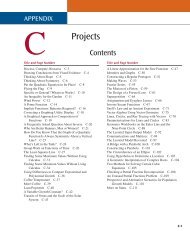HUsing ADO.NET 2.0 with Microsoft Access Databases - Cengage ...
HUsing ADO.NET 2.0 with Microsoft Access Databases - Cengage ...
HUsing ADO.NET 2.0 with Microsoft Access Databases - Cengage ...
You also want an ePaper? Increase the reach of your titles
YUMPU automatically turns print PDFs into web optimized ePapers that Google loves.
Programming Tutorial 33<br />
Appendix H C5779 39147 Page 33 07/10/06--JHR<br />
The dataset contains nine records,<br />
each having six fields<br />
FIGURE H.45<br />
Data displayed in the Preview Data dialog box<br />
13. Click the Close button in the Preview Data dialog box, then save the solution.<br />
Next, you will bind the field objects in the dataset to the appropriate text boxes on the form.<br />
To bind the field objects to the text boxes, then test the application:<br />
1. Click the Question field object in the Data Sources window, then drag the Question field object to the<br />
questionTextBox, as shown in Figure H.46.<br />
questionTextBox<br />
Question field object<br />
Question field object being dragged<br />
to the questionTextBox<br />
FIGURE H.46<br />
Question field object being dragged to the questionTextBox<br />
2. Release the mouse button. The computer binds the Question field object to the questionTextBox. It also adds<br />
the TriviaDataSet, Game1BindingSource, and Game1TableAdapter objects to the component tray, as shown in<br />
Figure H.47.
















